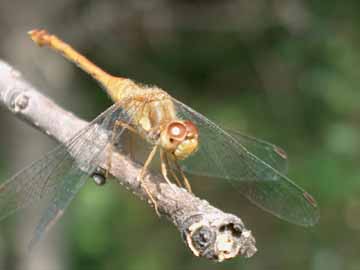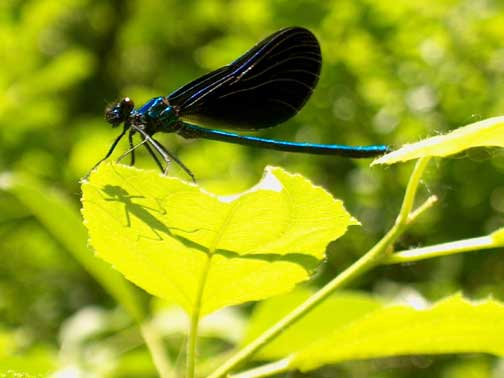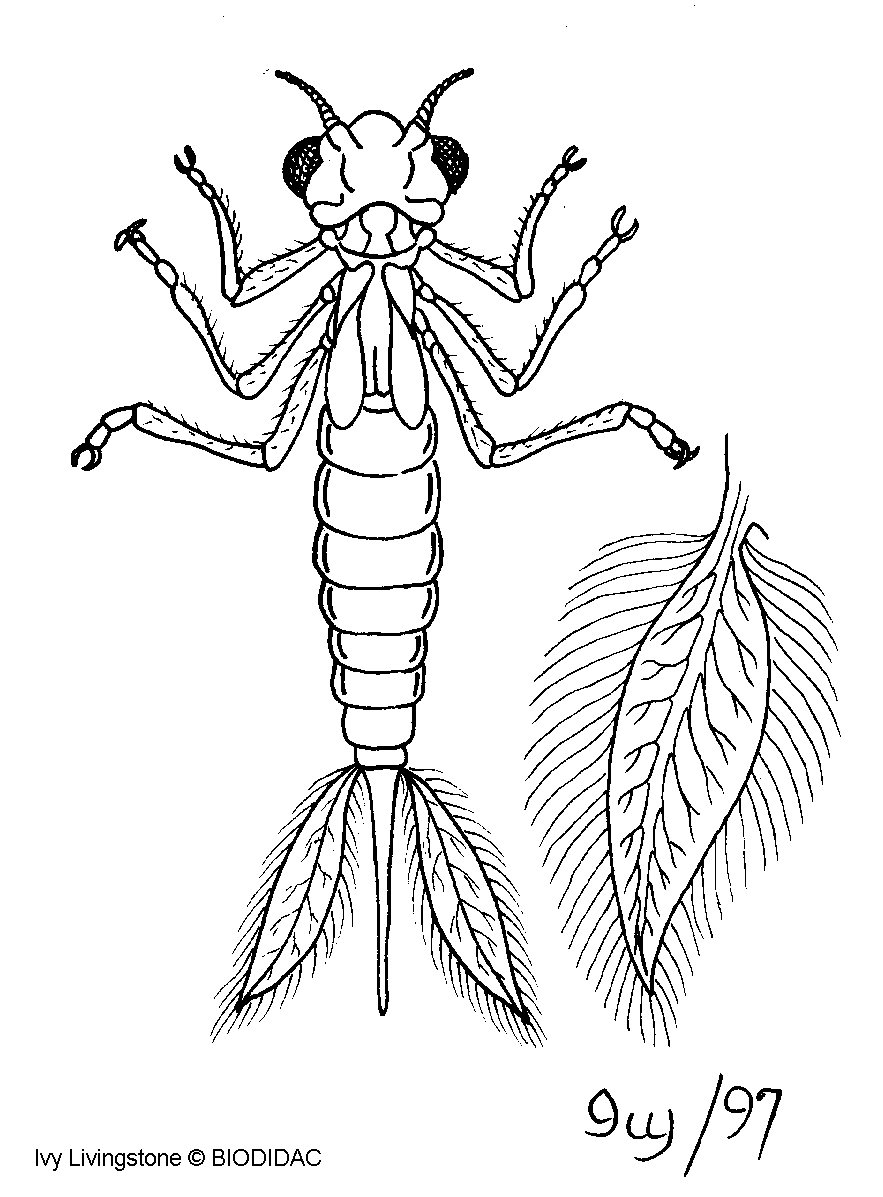

|
|
Biology Photo of the Month - July-August 2002Black-winged damselfly(Class: Insecta, Order: Odonata, Family: Calopterygidae)Photos and text by Bill Capman |
|
Close-up
of head of black-winged damselfly photographed near Minnehaha Falls
(several miles south of Augsburg College), on June 10, 2002
|
|
Move
cursor over photo to see wider view
|
The jaws and large bulging eyes of damselflies such as the one shown above are some of the last things seen by many a small insect, since damselflies, like their cousins the dragonflies, are highly predaceous. Indeed, not only are the adults of damselflies and dragonflies predators, but so are the aquatic immature stages, which have impressive hinged "jaws" (this structure is actually called the labium) that reach out quickly to strike and capture small aquatic insects, crustaceans, fish, and other aquatic animals.
For several short video clips showing the feeding behavior of dragonfly nymphs, go to: http://www.ento.vt.edu/~carroll/insect_video_feeding.html#dragonflyvideo
Though they are both members of the insect order Odonata, damselflies differ from dragonflies in several respects. As adults, damselflies are generally smaller and more slender than most dragonflies, and while dragonflies hold their wings outstretched even at rest, damselflies fold them back while at rest. Dragonflies are also usually faster, more powerful, and more acrobatic fliers, and are expert at capturing flying insect from the air.
 |
 |
Dragonfly
on left, damselfly on right. Dragonflies keep their wings spread all
the time, while damselflies fold their wings back when resting,
(Dragonfly photographed at Glacial Lakes State Park in
southwestern Minnesota, damselfly photographed in Minneapolis, MN near
Minnehaha Creek, downstream from Minnehaha Falls)
Damselflies and dragonflies also differ as nymphs. While nymphs of both are aquatic predators, damselflies have three leaf-like appendages at the tips of their abdomens that function as gills, but dragonflies have internal gills and breathe by pumping water in and out of their abdomens via an opening at the end of the abdomen (for photos of each of these general nymph body types, see http://insects.ummz.lsa.umich.edu/michodo/test/Subordrs.htm ). Nymphs of both generally spend most of their time sitting still or walking about (often seeking both prey and refuge on underwater vegetation), but both also have means of rapid escape when faced with danger. In the case of damselflies, the nymphs can swim by thrashing their bodies back and forth, using their gills to propel them similar to how fish use their tails. Dragonfly nymphs, on the other hand, are jet-propelled when faced with a dangerous situation. When they need to get away fast, they contract their abdomens rapidly, squirting water out of the opening at the end of the abdomen, which shoots them through the water.
 |
Diagram of a damselfly nymph, showing the leaf-like gills. Source of diagram: http://biodidac.bio.uottawa.ca/ |
The various damselfly and dragonfly families are quite diverse in habits and appearance (see http://www.esb.utexas.edu/jcabbott/odonata/photogalleries/index.html for a great collection of damselfly and dragonfly photos). The black-winged damselflies shown here are members of the family Calopterygidae, a family that contains some particularly attractive species. Some members of this family have clear wings, which is typical of most damselflies, but as can be seen in these photos, some others have have wings that are quite striking in appearance. The black wings of the species shown here give these damselflies a very fluttery appearance when in flight.
For most insects, definitive identification to the species level requires expert knowledge of the group of insects in question, and I am no expert in damselfly identification. However, the damselflies pictured here are similar if not identical to what other on the web have called Calopteryx maculata, so this might well be the species in my photos.
Click here or on photo for a MUCH closer view (118 KB)
Whereas some damselflies and dragonflies live near ponds or lakes (which are the bodies of water where the nymphs of those species live), the black-winged damselflies pictured here are usually found around streams since their nymphs are stream dwellers. On the day these photos were taken, these damselflies were quite conspicuous in the wooded area along Minnehaha Creek, between Minnehaha Falls and the Mississippi River. In some spots there were aggregations of 5 to 10 individuals resting in a single streamside bush or tree.
Dragonflies and damselflies have very interesting mating behavior, and some show very strong territoriality. For a great page on Odonata reproduction, including many wonderful photos showing copulating and egg-laying dragonflies and damselflies, go to: http://www.geocities.com/brisbane_dragons/Mating.htm
Additional Links
Additional general information on the family Calopterygidae can be found at: http://insects.ummz.lsa.umich.edu/michodo/test/Caloptx.htm
A terrific introduction to the dragonflies and damselflies can be found at http://www.ucmp.berkeley.edu/arthropoda/uniramia/odonatoida.html
Odonata Central is a Texas-based web site that has abundant information and many interesting links having to to with the order Odonota. For Odonata Central, go to: http://www.esb.utexas.edu/jcabbott/odonata/index.html
See also: